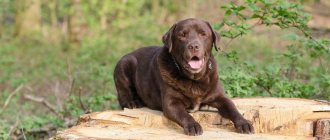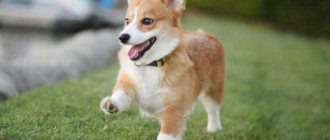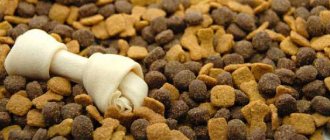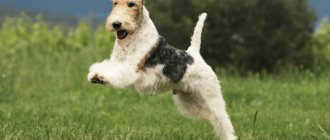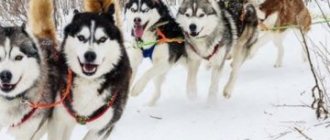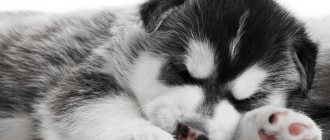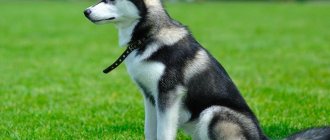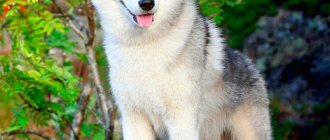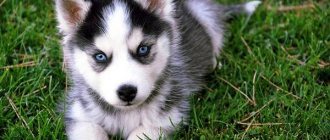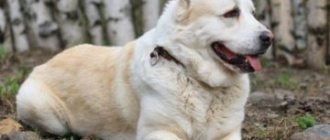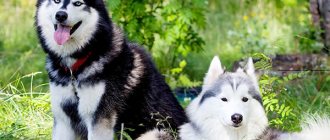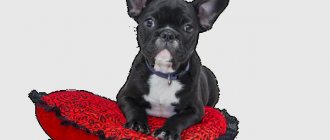The Alaskan Malamute is highly prized in the north. In northern latitudes it is used as a sled dog. An adult Alaskan Malamute dog is distinguished by sociability, endurance, large size, ability to work and a strong character, which is incredibly combined with friendliness.
Representatives of the oldest breed, walking with their owner, become the center of attention and arouse the admiration of others. They are often confused with cheerful and cheerful huskies. However, there is still a difference between the Alaskan Malamute and the Husky.
The main features of these wonderful dogs are strong limbs and great drafting ability. But it is their pretty appearance that makes Malamutes everyone’s favorite.
Where did Alaskan Malamutes come from?
The Alaskan Malamute dog is not only in great demand among northern peoples, but is also one of the oldest North American breeds. In addition, it is considered one of the most ancient on earth. There are suggestions that Alaskan Malamutes have lived alongside people since Paleolithic times. They are confirmed by archaeological finds, proving the fact that Malamutes have remained virtually unchanged since that time. In 2004, geneticists analyzed the DNA of dogs and determined their significant similarity to the wolf. This discovery suggests that Malamutes are simply domesticated wolves. They came to North America along with their owners about fourteen thousand years ago.
In addition to the resemblance to a wolf, some other interesting facts were discovered. Their DNA was found to be similar to the Alaskan Klee Kai and Husky. But Malamutes differ from the latter in size and weight. They have a heavier skeleton and powerful build. The weight of an Alaskan Malamute ranges from 34 to 39 kilograms, while the largest Husky weighs no more than 27 kilograms.
Hunters and guards
Malamutes were not immediately involved in cargo transportation. In ancient times, Eskimos roamed the northern territories, trying to find food and conditions suitable for life. Dogs also wandered with them, helping the men in hunting and protecting the tribe. They received such characteristics of the Alaskan Malamute breed, which are inherent in modern dogs, from their ancestors. Harsh climatic conditions and a limited amount of food made the animals strong and resilient. Weak individuals simply did not survive, falling out of the genetic chain to give way to the strong and fit.
For several centuries, the development of the breed took place on the territory of the Anvik River. The Eskimos of the Malemute tribe, who came to Alaska from Siberia, began to settle here. The tribe raised dogs to their own standards. Animals weren't supposed to be beautiful. The main characteristics of Alaskan Malamutes were strength, frost resistance, the ability to hunt and carry loads. Thanks to natural and human selection, animals have become what we know them today.
Malamutes in Europe
Over time, the Alaskan Malamute breed became popular in Europe. Domestic wolves appeared in Europe at the end of the 19th century, although people had heard about them for a very long time. The gold rush contributed to its popularity. It was thanks to her that in 1896 people who wanted to get rich began to flock to the Klondike. And since movement in the northern area was difficult, the “help” of the Malamutes was needed. Due to the demand for these dogs, their prices have skyrocketed. For one individual they asked for 500 dollars, and for a team of 1500 thousand. Thus, furry giants became the most expensive and sought-after animals in the northern territories.
Then gold miners brought other breeds with them, trying to cross them with Malamutes. But their attempts to breed strong and resilient dogs were unsuccessful. The puppies turned out to be beautiful, but aggressive and quarrelsome. In addition, their driving characteristics were poor. Therefore, they refused to cross them with St. Bernards and Newfoundlands.
Rescue from extinction
The most important quality of Alaskan Malamutes is their endurance. However, their ability to adapt to climatic conditions and work in a team is significantly inferior to dogs of other breeds, as well as speed characteristics. To improve these data, breeders have tried to cross Malamutes with smaller breeds. As a result of such experiments, dogs almost completely disappeared. Enthusiastic breeders helped to avoid this disaster and restored the breed.
After the threat of extinction of the dogs had passed, over the next twenty years the breed was divided into three lines. These were Hinvan-Irwin, M'Luth and Kotzebue. Representatives of these lines are the ancestors of modern Alaskan Malamutes, which retain the features of one line or another.
Official symbol of Alaska
Due to World War II, the Alaskan Malamute was once again endangered. In 1947, there were only 30 purebred individuals left. To save the breed from extinction, breeders had to deviate from the usual standards and established breed lines. However, such sacrifices still bore fruit. Malamutes were not only preserved, but also made one of the most popular dog breeds.
In the distant past, Alaskan Malamutes were ordinary sled dogs, but now they have become one of the official symbols of Alaska. However, despite the high status of the breed, efficient and hardy dogs in the northern regions continue to be used for transporting heavy loads.
Useful video
From the video you will learn everything about the Malamute dog breed:
Hello, dear readers!
This is a large native dog breed. Used for sled riding and cargo transportation. It got its name from the Malemute tribe of Eskimos living in Alaska, who developed it. The breed turned out to be in great demand during the exploration of Alaska and during the “gold rush”. During the war of 1941, these animals were used for military service, as a result of which they were practically exterminated. The surviving purebred individuals were bred. By the mid-20th century, the Malamute population was revived and increased in number. In 2010, the Alaskan Malamute was awarded the status of a symbol of Alaska.
Features and external data of the breed
If we study in detail the description of the Alaskan Malamute, we will see that it is a large, strong and beautiful dog, which has an extraordinary resemblance to a wolf. In addition to its spectacular appearance, the dog stands out for its irrepressible energy, which not all owners can cope with. Despite the fact that dogs are good-natured towards people, they prefer to dominate them.
If in everyday life the independent character of the Alaskan Malamute is not very pleasing to the owners, then in extreme situations this feature is a big plus. Dogs are able to make their own decisions and save their lives and the lives of their owners in dangerous situations.
In Russia, for a long time, Malamutes were something exotic. However, now the breed has a large number of fans. True, often this admiration for a dog begins to fade as it grows up, because if it is raised incorrectly, it becomes uncontrollable.
This is not the animal's fault. It is the people themselves who are to blame for buying a handsome fluffy dog, hoping that he will grow up obedient and flexible. Without proper education, training and care, it will not be possible to raise a worthy family member. Therefore, if a person is not going to devote a large amount of time to the dog and does not consider it necessary to take into account the dog’s character traits, he should refuse to buy a Malamute.
However, if the future owner of a pet wolf begins to take care of the puppy from the first days, trains it according to the advice of dog handlers, cares for it and devotes the necessary amount of time, then he will not only raise an excellent dog, but also a true faithful friend who understands him at a glance.
Appearance and features inherent in Malamutes
The Alaskan Malamute has a strong build, a muscular body and a dense, thick coat. Representatives of the breed are distinguished by a large head and deep chest, so even female Malamutes have a rather impressive appearance. But looking at the puppies that look like cute teddy bears, it’s hard to believe that in the future they will turn into huge, energetic dogs.
Although dogs have a large skull, it is not heavy. The muzzle is large compared to the black box. The stop is not sharp, but quite noticeable. Dogs have wide jaws with large teeth. A correct bite should be a scissor bite.
Malamutes have almond-shaped, medium-sized, brown eyes. If the iris is blue, then this is considered a disqualifying defect. Dogs have medium, triangular ears. The nose is large with wide nostrils and a black nose.
The neck is powerful and strong. The body is massive with strong bones. The tail is straight, fluffy, raised above the back. The forelimbs have developed muscles and are massive. The paw pads are large, collected, developed with tightly closed toes and protective hair between them. The hind legs are also strong and massive. They are located in line with the front ones.
Malamutes have a double coat. The first type of coat is guard and hard, and the second is soft and dense. In winter, dogs have long hair, and in summer it is shorter and not as thick.
The colors of Alaskan Malamutes are few. The most common is the wolf one. Also, representatives of the breed can be black, gray, white and sable. Colors can be combined. But this is only permissible in the undercoat and underpants area. Color combinations elsewhere are not permitted. The white color is more in the lower part of the body, on the paws and face in the form of a mask. A white spot on the forehead and a stripe on the back of the neck are allowed.
"Important! The color of Alaskan Malamutes is called mantle, this eliminates the presence of both uneven color and spots that break it.”
Possible disadvantages
Any deficiencies and pathologies of a dog’s limbs are considered serious defects. In Malamutes they are represented by a cow-like set of hind legs, their spacing, weak pasterns, straight shoulder girdle or insufficient angles.
Also defects are stilted or other types of movements, incorrect proportions, too powerful or, conversely, a slender physique.
Disqualifying faults
These include blue irises or other obvious physical abnormalities. Mental symptoms include cowardice or increased aggression. Also a defect will be cryptorchidism detected in a male dog.
Description
Although often mistaken for their close relatives Siberian Huskies, Alaskan Malamutes are the largest and oldest dog in the north. Powerful, sporty, tough, they are designed to transport heavy loads over long distances.
The height of males at the withers is up to 64 cm and weight 39 kg, while females reach 58 cm and 34 kg. However, individuals with larger or smaller sizes are more common. When evaluating a dog, more attention is paid to type of proportionality, agility, and other functional characteristics rather than size.
Malamute (left) and husky. The differences are obvious
The head is large, wide, relatively proportional to the body. When viewed from the front, the head and muzzle should resemble a wolf.
The eyes are medium-sized, almond-shaped, with the outer corners of the eyes located higher than the inner corners. Eye color must be brown, blue eyes are a disqualifying fault.
The ears are medium in size, triangular in shape, with slightly rounded tips, set wide apart on the head.
The Alaskan Malamute has a thick double coat, with coarse guard hairs and a dense undercoat. The undercoat is dense, oily and dense, providing excellent protection. In summer, the coat becomes less dense and short.
Color ranges from gray wolf to black, sable and various colors. Can be white, plain color. A combination of colors is allowed in the undercoat and marks on the trousers.
Character of Alaskan Malamutes
This is just a photo of an Alaskan Malamute, calm and peaceful. In life, things are far from being like that. These dogs are not lazy and cannot be classified as couch potatoes. They are very energetic and require constant attention from their owner. Many people believe that a long walk will force the pet to come home and go to bed. No. He will run around the apartment like crazy and continue to chew furniture and do other indecent things. Living in a private house, the dog will dig huge holes in the yard and try to jump over even the highest fence. The dog's irrepressible energy is to blame. For the first three years you will have to work hard and train her. You will need to take long walks with your pet and learn the rules of good manners. You should not expect the dog to become calm; its remarkable energy will decrease slightly only after three years.
Malamutes are similar to a wolf not only in appearance, but also in their habits. That's why they are bad defenders. Dogs cannot bark, but they howl beautifully, and they love it. These fluffy beauties are distinguished by their good nature and sociability. However, if they are not raised correctly, these qualities will turn into uncontrollability and constant attempts to dominate the family. The dog must clearly understand that he is a pet, not an owner, otherwise there will be big problems with him.
Fluffy handsome men with gangster habits
Despite its playful character, the Alaskan Malamute has an excellent memory. Therefore, domestic wolves must be treated with due respect, since they remember bad treatment well and can, on occasion, take revenge for it.
Entertainment for dogs is unique. If they get tired of the routine, they will start rushing around the yard, house or apartment, demolishing everything that gets in their way. They do not like confined spaces, so you should not keep such dogs in an apartment. A spacious enclosure and a large yard will suit them. In addition, you should walk with them for several hours every day. It is better not to leave other animals and small children alone with the dog. She is large and very playful, so she can accidentally injure those who are smaller and weaker than her.
Abstracts
- Not recommended for inexperienced hobbyists as their natural intelligence and independence make them difficult to train.
- Malamutes will strive to dominate the family, and each member must be willing (and able) to place himself in a position higher than them.
- They dig well, it's in their nature. This should be taken into account if the dog lives in the yard, as it can damage the plants and it can dig under the fence.
- This large, energetic dog is designed to carry loads. If not properly trained and bored, she can become destructive in the home.
- With proper socialization and training, Malamutes can live in homes with dogs and cats. But, these rules do not apply, and they will hunt small animals, including neighbor's cats.
- They cannot bark (with rare exceptions), and their thick coats are not designed for hot climates.
Educational moments and training of Alaskan Malamutes
Malamutes are characterized by intelligence and mobility from birth. Malamute puppies try to become leaders even in early childhood. Therefore, the owner must show consistency and firmness in raising the baby. Physical activity should be increased as you grow older. It is necessary to train an Alaskan Malamute puppy immediately after purchase. First of all, he needs to be taught neatness and his own name.
The dog should also be socialized. You can start visiting the training ground at four months. There she can not only learn new commands, but also find playmates. In addition, she will learn to react calmly to cars and extraneous sounds, thus strengthening her nervous system and learning to live in a metropolis.
Character and temperament
Malamutes have a friendly disposition and sometimes even behave overly friendly with people. These are quite large dogs, but they cannot be used as guards, since they are not characterized by aggression and are very friendly towards everyone, even strangers.
They are pack animals that need constant contact with other dogs or people. They cannot live alone; such conditions negatively affect their mental and physical health.
Malamutes, despite their devotion and loyalty, cannot be called dogs of one owner - as soon as a person shows weakness and ceases to be a leader and leader for the pet, representatives of this breed will switch to another, one in whom they see these qualities.
These dogs are smart and quickly remember commands, but their natural stubbornness and desire to dominate takes over and they may refuse to follow commands, which complicates the process of training and education. When raising a Malamute, it will not be superfluous to undergo the OKD.
Malamutes need regular active walks and physical activity to help maintain health and get rid of accumulated energy.
Maintenance and care
Since Alaskan Malamutes have a very thick coat, they can be kept outdoors all year round and are not afraid of frost. In summer it becomes more rare. To keep your pet's coat in good condition, it should be carefully looked after. The dog needs to be brushed every few weeks.
To prevent the dog from getting bored, tearing up furniture and digging trenches in the backyard, you need to walk him for several hours every day. This way, the dog will not only expend indefatigable reserves of energy, but can also maintain the necessary shape.
Malamutes cannot be considered gourmets; they can be fed natural food. Often their owners give their pets porridge with meat. However, you can give them dry food, but it must be suitable for this breed and belong to the premium class. Even if the dog consumes more food than it needs, it will not gain weight, since its lifestyle simply will not allow it.
Pet care
The breed requires a lot of attention when caring for it . You should not get a dog if you cannot pay due attention to its appearance and health.
Ears
The condition of Malamutes' ears is checked every day . Clean with a swab soaked in a special lotion every week. If you notice an unpleasant odor or any discharge, you should contact your veterinarian.
Claws
If the claws do not grind down naturally, then use a special metal nail clipper. The haircut procedure is carried out as needed.
Eyes and teeth
Eyes are examined every day . If necessary, wipe with chamomile decoction. This usually happens 5-6 times a month.
Teeth are also examined daily . Clean once a week using special pastes to prevent plaque and tartar formation.
Wool
Special attention is paid to wool. The breed is quite clean and there is often no “dog” smell. However, this does not exempt them from bathing.
Dogs are not washed often - once every 2-3 months . But they must be combed once a week, and even every day during the molting period. Long, thick hair without proper care will roll up and turn into tangles.
Health of Alaskan Malamutes
The description of the breed indicates that the dogs are very hardy and have excellent health, but they are still susceptible to some diseases. Most often they develop a neurological disorder called polyneuropathy.
Dogs may also be diagnosed with hip problems. Malamutes also suffer from hemophilia, diabetes, dermatitis, anal adenocarcinoma and demodicosis.
As your pet ages, it can develop cataracts and glaucoma. Some representatives of the breed experience bloating and hypothyroidism. At the same time, Alaskan Malamutes are long-lived and with proper care can live up to 20 years.
Life expectancy and health
Malamutes from the Chinese breeding line live 10-12 years with proper care and nutrition . However, due to a genetic predisposition to diseases of the joints and heart, few dogs live to this age.
Chinese Malamutes are susceptible to the following diseases:
- dysplasia of the hip and elbow joints;
- ear infections;
- heart diseases;
- osteochondrosis;
- diabetes;
- eye diseases;
- skin diseases.
Choosing a Malamute puppy
Before you buy an Alaskan Malamute, there are a few important rules to consider. To avoid possible risks, it is better to purchase a puppy from a kennel or registered breeders. Perhaps in this case the price of a Malamute puppy will be high, but the future owner will be able to be sure that he has acquired a purebred representative of the breed.
In addition to the pedigree, a small Alaskan Malamute must have documents from the RKF and SKOR. Club documents should not be trusted, since in the end the dog may turn out to be either not purebred or have defects.
A baby should be purchased between 1 and 4 months of age. Month-old puppies are taken by those owners who want the little Malamute to begin to get used to a new family from infancy. But if the future owner wants to see the makings of the exterior and character, then he should wait until the baby grows up a little.
Regardless of how old the puppy is, he should be active, cheerful and playful. Healthy Malamute puppies should look like little bears with dark eyes, thick paws and a tail. The color of the baby should match the color of the adult. The coat should be thick and fluffy. If a small Malamute has show potential, then in addition to its appearance it must have a daring and self-confident character.
To choose a child who will grow up balanced and have leadership abilities, you need to check him as follows. You should put a collar and leash on the puppy, and then call him to follow you. If he follows his future owner without any problems, then he will grow into a worthy and well-mannered Malamute.
Breed standard
Malamutes are powerful, strongly built dogs with a compact, square body and strong paws with well-developed muscles. All this makes them ideal sled, working and hunting dogs.
NOTE!
This is one of two breeds in the world whose representatives do not bark, but make sounds reminiscent of a grunt.
breed standard
:
- the head is wide, but proportional to the body;
- the muzzle is voluminous, not pointed;
- the ears are erect, V-shaped, set wide, with rounded tips;
- scissor bite;
- the eyes are small, almond-shaped, the iris is brown;
- The nose is pigmented black or brown.
Excessive body weight, thinness, incorrect positioning of the limbs or their discrepancy with the accepted and approved form of the standard, as well as disproportionality of the body are serious disadvantages of the breed.
Dogs with blue eyes and any manifestation of aggressive behavior are also considered a deviation from the breed standard.
Malamute puppies cost
Those who are planning to buy a northern beauty are probably wondering how much an Alaskan Malamute costs? If the future owner is going to purchase an exhibition specimen, then the puppy will cost him around 100 thousand rubles. A small Malamute without documents will cost several times less and will cost about 15 thousand rubles. Such a huge difference in price is ensured by the fact that purebred puppies are suitable for breeding, and babies without a passport are purchased only for the soul.
The price of Alaskan Malamute puppies can also be influenced by the title of its parents. The more regalia they have, the more expensive their babies will be.
Price range
Before the ban on breeding Chinese Malamutes was introduced, the dogs had the highest price . The price for a puppy reached 200 thousand rubles.
Malamutes of the Chinese line are very beautiful and intelligent dogs. They get along easily with humans, children and other animals.
Suitable for outdoor use . However, an inexperienced breeder should hold off on purchasing a puppy of this breed.
Interesting facts about Alaskan Malamutes
How did it happen that the breed of northern dogs became popular even where there is no trace of snow? This happened when they learned about Alaskan Malamutes in America, and it was thanks to the Americans that these amazing dogs spread throughout the world.
Why do these furry giants attract dog lovers so much? Let's get acquainted with interesting facts about Malamutes.
- Dogs of this breed starred in the famous film “White Captivity”.
- Malamutes are very hyperactive and simply love to dig in the ground, which is why they got the name shrews.
- Dogs cannot bark, but they love to howl. This quality was inherited from their ancestors.
- When you press on the pads of the paws, the claws of Malamutes come out, like those of cats.
- Dogs of this breed are excellent hunters and catch everything that moves.
- Malamutes do not grow up by one year, like ordinary dogs, but only by three years.
- Northern dogs do not like to swim and do not tolerate heat well.
As you can see, these are not only cute, fluffy giants, but also real descendants of the Arctic wolf, who have firmly entered the hearts of dog lovers and settled there forever.
Advantages and disadvantages
Positive sides:
- Guard qualities. With Tibetan Mastiff roots, the dogs are predisposed to guard. They know their owners and their associates well, they are aggressive towards strangers, but will not cause harm.
- Suitable for aviary and outdoor keeping. Due to their thick and long coat, Chinese Malamutes are not afraid of frost and can easily endure winters.
- Balanced character. Dogs of this breed are calm, not aggressive and get along well with children and other animals.
- Mental capacity. Dogs are developed, intelligent and easy to train. They feel weak people and stop obeying them. Therefore, they are recommended only for experienced dog breeders.
Negative sides:
- Care. Since the dog has long and thick hair, it is necessary to keep an eye on it. This takes a lot of time.
- Stubbornness. Chinese Malamutes can be mischievous, and sometimes you have to negotiate with them. At the same time, you need to show strength of character and stand your ground to the end, then the dog will show respect for the owner.
- Digging holes. In ancient times, the ancestors of Malamutes ate burrowing animals; this habit was passed on to modern dogs. Therefore, if you keep an animal in a private house on the street, you need to be prepared for constant holes in the yard.
- Expensive to feed. Dogs are of impressive size and therefore need to be fed in fairly large portions. Quality food will cost a pretty penny.
